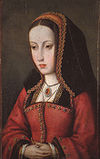- Count of Barcelona
-
The Catalan/Valencian cultural domain LanguageHistory · Grammar · Phonology · Orthography
Institut d'Estudis Catalans
Acadèmia Valenciana de la Llengua
Institut & Fundació Ramon LlullGeo-political divisionsGovernment and PoliticsGeneralitat de Catalunya · Generalitat Valenciana
Govern de les Illes Balears
General Council of the Valleys (Andorra)
General Council of the Pyrénées-Orientales
Politics of Andorra · Politics of Catalonia
Catalanism · ValencialismTraditions and SymbolsCastells · Correfoc · Gegants i capgrossos · Falles
Nit de Sant Joan · Moros i cristians · St George's Day
Caganer · Tió de Nadal · Muixeranga · Sardana
Pa amb tomàquet · Botifarra · Paella · Ensaïmada
Symbols · Myths and legendsArtsDecadència · Renaixença · Modernisme · Noucentisme
Ramon Llull · Ausiàs March · Jacint Verdaguer
Antoni Gaudí · Salvador Dalí · Joan Miró
Joaquim Sorolla · Antoni Tàpies · Lluís Llach
Rumba catalana · Rock català · Nova cançó
Literature · MusicThe Count of Barcelona (Catalan: Comte de Barcelona, Spanish: Conde de Barcelona) was the ruler of Catalonia for much of Catalan history, from the 9th until the 17th century.
The County of Barcelona was created by Charlemagne after he had conquered lands north of the river Ebro. These lands, called the Marca Hispanica, were partitioned into various counties, of which the Count of Barcelona, usually holding other counties simultaneously, eventually obtained the primacy over the region.
As the county became hereditary in one family, the bond of the counts to their Frankish overlords loosened, especially after the Capetian dynasty supplanted the Carolingians.
In the 12th century the Counts formed a dynastic union with the Kingdom of Aragon, merging the two realms under a single ruler. In 1258, the king of France relinquished his feudal authority over the County in the Treaty of Corbeil.
Barcelona remained part of the Crown of Aragon when the latter around 1500 entered into a union with the Kingdom of Castile, thereby forming the Spanish Kingdom. The maintained its own laws, taxes and privileges until they were removed after the War of the Spanish Succession in the 18th century.
Count of Barcelona remained one of the many hereditary titles of the Spanish monarchy.
In the 20th century, the title regained some prominence when Juan de Borbón, the exiled heir to the Spanish throne, adopted the title of Count of Barcelona. In doing so, he claimed a historical royal title without claiming to be the current king of Spain, especially after his son Juan Carlos became the prospective successor of the then-ruler of Spain, Francisco Franco. In 1977, after Juan Carlos had become King upon Franco's death in 1975, he officially awarded the title of Count of Barcelona to his father, who had renounced his rights to the throne. Juan held that title until his death in 1993, when it reverted back to the King who has held it ever since. Juan de Borbón's widow used the title Countess of Barcelona until her death in 2000.
Contents
List of Counts of Barcelona
Non-dynastic, 801-878
Name Portrait Reign Notes Berà 801-820 son of William of Toulouse, also Count of Girona, Besalú, Ausona (812/817-820), Razès and Conflent (790-820), deposed. Rampó 820-826 also Count of Girona, and Besalú Bernard I
(Bernat I)826-832 son of William of Toulouse, also margrave of Septimania (834-835) and Imperial Chamberlain (829-830), deposed. Berenguer 832-835 also count of Toulouse. Bernard I
(Bernat)836-844 restored, executed on orders of Charles the Bald. Sunifred 844-848 son or son-in-law of Belló of Carcassone, also Count of Ausona, Besalú, Girona, Narbonne, Agde, Béziers, Lodève, Melgueil, Cerdanya, Urgell, Conflent and Nîmes. William
(Guillem)848-850 son of Bernard I, also Count of Toulouse (844-850), rebelled and was killed. Aleran 850-852 jointly with Isembart, also Count of Ampurias and Roussillon and Margrave of Septimania. Isembart 850-852 son of Guerin of Provence, jointly with Aleran, also Count of Ampurias, and Roussillon and Margrave of Septimania. Odalric 852-858 son of Hunfrid, Margrave of Istria, also Count of Girona, Rosselló, Empúries and Margrave of Septimania. Humfrid 858-864 son of Hunfrid II, Duke of Rhaetia, also Count of Girona, Empúries, Roussillon and Narbonne, Margrave of Gothia. Bernard II (Bernat II) 865-878 son of Bernard of Poitiers also Count of Girona and Margrave of Gothia and Septimania, rebelled. House of Sunifred, 878-1162
Name Portrait Reign Notes Wilfred I
(Guifré I)
el Pelós (the Hairy)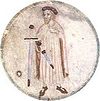
878-897 son of Sunifred I, managed to establish hereditary succession Wilfred II Borrel I
(Guifré II Borrell)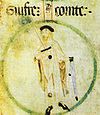
897-911 son of Wilfred the Hairy Sunyer 
911-947 son of Wilfred the Hairy, retired to a monastery Borrell II 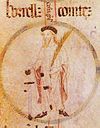
947-992 son of Sunifred II
jointly with Miro I (947-966) and Ramon Borrell (988-992),
also Count of Urgel (948-992). Unsuccessfully asked King Lothair of France for aid against the Saracens, refused to recognise Hugh Capet as King of France in 987.Miro 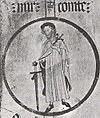
947-966 son of Sunifred II, jointly with Borrell II Ramon Borrell 
988-1018 son of Borrell II, jointly with his father (988-992) Berenguer Ramon I
el Corbat (the Crooked)
1018-1035 son of Ramon Borrell, under the regency of Ermesinde of Carcassonne (1018-1023), forced to recognise the suzerainty of Sancho the Great of Navarre. Ramon Berenguer I
el Vell (the Old)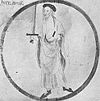
1035-1076 son of Berenguer Ramon I Ramon Berenguer II
el Cap d'Estopes (the Towhead)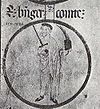
1076-1082 son of Ramon Berenguer I, jointly with his twin brother Berenguer Ramon II Berenguer Ramon II
el Fratricida (the Fratricide)1076-1097 son of Ramon Berenguer I, jointly with his twin brother Ramon Berenguer II (1076-1082) and his nephew Ramon Berenguer III (1082-1097) Ramon Berenguer III
el Gran (the Great)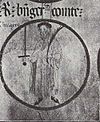
1082-1131 son of Ramon Berenguer II Ramon Berenguer IV
el Sant (the Saint)
1131-1162 son of Ramon Berenguer III, engaged Petronilla of Aragon in 1137 and married her in 1150. House of Aragon-Barcelona, 1162-1410
See also: List of Aragonese monarchsRamon Berenguer IV married Petronilla of Aragon, which established the dynastic union with Aragon. On his death, their son Alfonso II succeeded to both thrones, uniting Barcelona and Aragon within the Crown of Aragon.
Name Portrait Reign Notes Alfonso II of Aragon / I of Barcelona
el Cast (the Chaste)
el Trobador (the Troubadour)
1162-1196 son of Ramon Berenguer IV and Petronilla of Aragon Peter II of Aragon / I of Barcelona
(Pere I)
el Catòlic (the Catholic)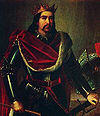
1196–1213 son of Alfonso II James I
(Jaume I)
el Conqueridor (the Conqueror)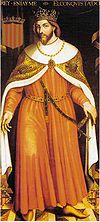
1213-1276 son of Peter the Catholic, signed Treaty of Corbeil in 1258, in which King Louis IX of France relinquished his feudal authority over Barcelona. Peter III of Aragon / II of Barcelona
(Pere II)
el Gran (the Great)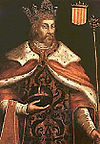
1276-1285 son of James I Alfonso III of Aragon / II of Barcelona
el Franc (the Frank)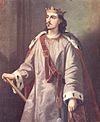
1285-1291 son of Peter the Great James II
(Jaume II)
el Just (the Just)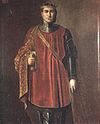
1291–1327 son of Peter the Great Alfonso IV of Aragon / III of Barcelona
el Benigne (the Good)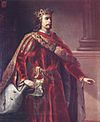
1327-1336 son of James II Peter IV of Aragon / III of Barcelona
(Pere III)
el Cerimoniós (the Ceremonious)
el del Punyalet (of the Dagger)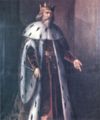
1336–1387
son of Alfonso the GoodJohn I
(Joan I)
el Caçador (the Hunter)
el Descurat (the Careless)
l'Amador de la Gentilesa (the Lover of Elegance)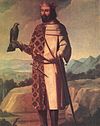
1387-1396 son of Peter the Ceremonious Martin I
(Martí I)
l'Humà (the Humanist)
l'Eclesiàstic (the Ecclesiastical)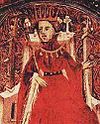
1396–1410 son of Peter the Ceremonious, died without issue. House of Trastámara, 1412-1516
See also: List of Aragonese monarchsWhen Martin, the last legitimate male-line descendant of Wilfred the Hairy to rule, died without legitimate heirs, the magnates of the different realms of the Crown negotiated for two years until the Compromise of Casp gave the throne to Ferdinand of Antequera, a scion of the Castilian House of Trastámara, and sister's son of Martin.
Name Portrait Reign Notes Ferdinand I
(Ferran I)
el d'Antequera (of Antequera)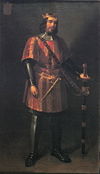
1412-1416 son of John I of Castile and Eleanor of Aragon Alfonso V of Aragon / IV of Barcelona
el Magnànim (the Magnanimous)
1416-1458 son of Ferdinand I John II
(Joan II)
1458-1479 son of Ferdinand I John's title to Aragon and Barcelona (but not to Valencia) was opposed by Henry IV of Castile 
1462-1463 son of John II of Castile and Maria of Aragon Peter V of Coimbra 1463-1466 son of Pedro, Duke of Coimbra(House of Aviz) and Isabel of Aragon. René d'Anjou
(Renaut)
1466-1472 son of Louis II of Naples and Yolande of Aragon, titular King of Naples, House of Valois-Anjou Ferdinand II
(Ferran II)
el Catòlic (the Catholic)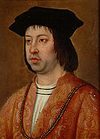
1479-1516 son of John II, married Isabella I of Castile in 1469 Joanna
(Juana)
la Loca (the Mad)1516-1555 daughter of Ferdinand II, married Philip I of Castile in 1496 House of Habsburg, 1516-1700
See also: List of Spanish monarchsFerdinand II married Isabella I of Castile and thus united Spain. He was succeed by his grandson Charles, with whom the Habsburg Dynasty acceded to the Spanish kingdoms:
Name Portrait Reign Notes Charles I
(Carles I)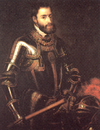
1516-1556 grandson of Ferdinand II Philip I
(Felip I)
1556-1598 son of Charles I Philip II
(Felip II)
1598-1621 son of Philip I Philip III
(Felip III)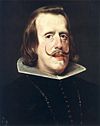
1621-1665 son of Philip II During the Reapers' War, the County of Barcelona was claimed by French Kings from the House of Bourbon: Louis XIII of France 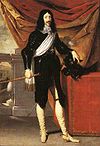
1641-1643 Louis XIV of France 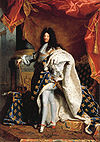
1643-1652 Charles II
(Carles II)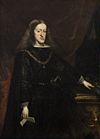
1665-1700 son of Philip III, died without issue. War of the Spanish Succession, 1700-1714
During the War of the Spanish Succession, Spain (and with it, the County of Barcelona) was claimed by:
Name Portrait Reign Notes Philip IV
(Felip IV)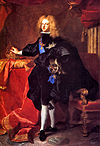
1700-1714 son of Louis, Dauphin of France; recognised in Barcelona 1700-1705. Charles III
(Carles III)
1705–1714 son of Leopold I, Holy Roman Emperor; recognised in Barcelona 1705-1714. In the Nueva Planta decrees between 1707 and 1716, Philip declared that all Spanish kingdoms and territories should merge into a single, centralized Kingdom of Spain. In Barcelona this was promulgated in 1716. The County of Barcelona became one of the many hereditary titles of the Spanish monarchy.
Courtesy title
House of Bourbon, 1977-1993
Name Portrait Reign Notes John III
(Juan III)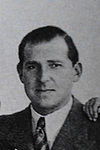
1977-1993 claimed title from 1941; officially granted by his son Juan Carlos I in exchange for renouncing his claim to the Spanish throne See also
Categories:- Counts of Barcelona
- Lists of monarchs
- Lists of counts
- Crown of Aragon
Wikimedia Foundation. 2010.



